ZHU DA[TCHOU TA](1626-1705)
Bibliographie
Bada shanren yanjiu : lunwen ji xuanji, Jiangxi renmin chubanshe, Nanchang, 1986
R. Barnhart et al., Master of the Lotus Garden : the Life and Art of Badashanren (1626-1705), Univ. Press, New Haven, Londres, 1990
F. Cheng, Chu Ta, 1626-1705, le génie du trait, Phébus, Paris, 1986
W. Fong, « Stages in the life and art of chu Ta (1626-1705) », in Archives of Asian Art, t. XL, p. 6, 1987 ; « Some problems Concerning Pa-ta shanjen » (appendice à « A Letter from shih-t'ao to Pa-ta shan-jen »), in Archives of Chinese Art Society of America, t. XIII, p. 22, 1959
Wang Fangyu, Bada shanren lunji, 2 vol., Guoli bianyiguan zhonghua congshu bianshen weiyuan, Taipei, 1984
Wang Fangyu, R. M. Barnhart& J. G. Smith, Master of the Lotus Garden : the Life and Art of Bada Shanren, 1626-1705, catal. expos., Yale Univ. Art Gallery, Yale Univ. Press, New Haven, 1990
Zhong Yinglan, Ba Da Shanren le peintre-moine, éd. Young-Feng, Paris, 2004.
La suite de cet article est accessible aux abonnés
- Des contenus variés, complets et fiables
- Accessible sur tous les écrans
- Pas de publicité
Déjà abonné ? Se connecter
Écrit par
- Pierre RYCKMANS
:
reader , Department of Chinese, Australian National University
Classification
Autres références
-
CHINOISE CIVILISATION - Les arts
- Écrit par Corinne DEBAINE-FRANCFORT , Daisy LION-GOLDSCHMIDT , Michel NURIDSANY , Madeleine PAUL-DAVID , Michèle PIRAZZOLI-t'SERSTEVENS , Pierre RYCKMANS et Alain THOTE
- 54 390 mots
- 37 médias
...se plaît au petit format des feuilles d'album, et son art témoigne d'une compréhension globale et convaincante des éléments naturels. Moine lui aussi, Zhu Da (1626-1705) peint avec une égale spontanéité paysages et animaux. Le pinceau large ou crispé, l'encre sèche ou coulante dialoguent en des esquisses... -
PEINDRE HORS DU MONDE, MOINES ET LETTRÉS DES DYNASTIES MING ET QING (exposition)
- Écrit par Christian HECK
- 1 276 mots
- 1 média
Le Poisson, deZhu Da, dit Bada Shanren (1626-1705), qui passa l’essentiel de sa vie comme moine bouddhiste, illustre la puissance d’évocation de l’encre lorsqu’elle est, dans la même œuvre, utilisée avec différentes dilutions, et que les formes sont rendues sans traits de contours. Le poisson est...



